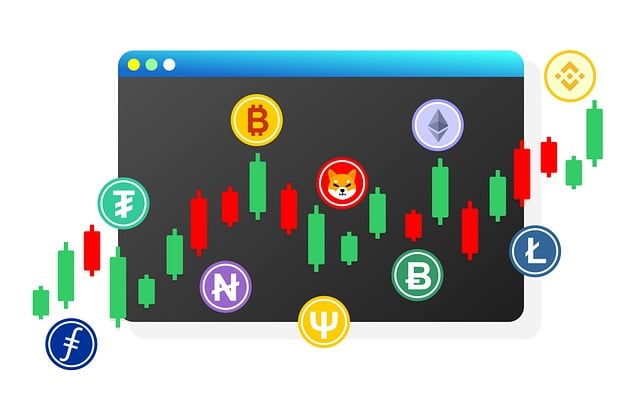Investing in crypto during economic downturns requires securing digital assets with robust cryptocurrency wallets. Types include hot (online) and cold (offline) storage, each offering convenience/security trade-offs. Protecting private keys through multi-platform storage, encryption, regular backups, and using secure hardware wallets is crucial against cyber threats. Staying updated on wallet software and industry standards enhances defense.
Investing in crypto during economic downturns comes with risks, but securing your digital assets is paramount. This article guides you through the essentials of cryptocurrency wallet security. From understanding the role of wallets in securing crypto to exploring different storage types and implementing best practices like strong passwords and 2FA, we cover it all. Learn how to back up and recover your wallet, protect against online threats, and keep your software updated for optimal safety.
- Understanding Cryptocurrency Wallets: Their Role in Securing Digital Assets
- Types of Cryptocurrency Wallets: Hot vs Cold Storage and Their Security Implications
- Best Practices for Creating a Secure Wallet: Strong Passwords and 2-Factor Authentication
- Backup and Recovery: Ensuring You Don't Lose Access to Your Crypto During Downturns
- Staying Safe Online: Protecting Your Wallet from Hackers and Phishing Scams
- Monitoring and Updating: Keeping Your Wallet Software Current for Optimal Security
Understanding Cryptocurrency Wallets: Their Role in Securing Digital Assets

Cryptocurrency wallets are digital storage spaces designed to safeguard your precious digital assets. They play a pivotal role in securing your investments during economic downturns when many turn to crypto as a hedge against traditional market volatility. When investing in crypto, understanding the nature and function of these wallets is paramount. Each type offers unique features catering to different user needs, from secure long-term storage (like hardware wallets) to fast transactions (software wallets).
Securing your private keys – the digital passwords that grant access to your wallet – is paramount. Wallets can be vulnerable to hackers if not properly secured. Using strong authentication methods like two-factor authentication and keeping your software updated are best practices. Remember, once your private keys are compromised, recovering lost funds is nearly impossible, underscoring the critical importance of robust security measures.
Types of Cryptocurrency Wallets: Hot vs Cold Storage and Their Security Implications

Cryptocurrency wallets can be broadly categorized into two types: hot storage and cold storage. Hot storage wallets are connected to the internet and offer users easy access to their funds at any time. These include software wallets and mobile wallets, which are convenient for frequent transactions but introduce higher security risks due to potential online vulnerabilities and hacking attempts. On the other hand, cold storage wallets are disconnected from the internet, typically in the form of hardware wallets or paper wallets, providing a much safer environment for long-term crypto asset preservation during economic downturns.
While hot storage offers liquidity, it leaves assets susceptible to cyber threats, where malicious actors can gain unauthorized access and steal funds. In contrast, cold storage minimizes these risks but requires users to securely manage private keys offline, often through physical devices or written backups. This dual nature of hot vs. cold storage underscores the need for investors considering crypto during economic downturns to weigh convenience against security when choosing a wallet type.
Best Practices for Creating a Secure Wallet: Strong Passwords and 2-Factor Authentication

When creating a cryptocurrency wallet, establishing robust security practices is paramount, especially during economic downturns when investing in crypto gains popularity. Two key elements to fortify your digital vault are strong passwords and enabling 2-Factor Authentication (2FA).
A secure password acts as the first line of defense, ensuring that only you have access to your wallet. It should be unique, long, and complex, combining uppercase and lowercase letters, numbers, and special characters. Avoid using personal information or easily guessable patterns. Consider a passphrase for added strength, making it memorable yet incredibly hard to crack. Meanwhile, 2FA adds an extra layer of protection by requiring a second form of verification, such as a one-time code from your mobile device, in addition to your password. This ensures that even if someone discovers or steals your password, they still can’t access your wallet without the second factor.
Backup and Recovery: Ensuring You Don't Lose Access to Your Crypto During Downturns

When investing in crypto during economic downturns, a robust backup and recovery strategy is paramount. This ensures your access to digital assets remains secure even if you face technical glitches or equipment failure. It’s crucial to store your cryptocurrency wallets across multiple, secure platforms and use encryption to safeguard private keys. Regularly updating these backups is essential; consider setting reminders or automating the process to ensure your crypto is always recoverable.
Beyond traditional backup methods, explore hardware wallets for enhanced security. These offline devices provide an extra layer of protection against cyber threats. Remember that while robust security measures are in place, staying informed about potential vulnerabilities and best practices will empower you to protect your crypto holdings through every economic cycle.
Staying Safe Online: Protecting Your Wallet from Hackers and Phishing Scams

Staying safe online is paramount when investing in crypto during economic downturns. Phishing scams and hacker attempts are more prevalent when markets are volatile, targeting unsuspecting individuals with fake websites and malicious links disguised as legitimate crypto services. Protect yourself by verifying the security and legitimacy of any wallet or exchange you use; look for secure connections (HTTPS) and two-factor authentication (2FA). Be wary of unusual communications, especially those demanding immediate action or sensitive information. Regularly update your software and antivirus programs to defend against known vulnerabilities. Lastly, never share your private keys or login credentials with anyone, as these are the digital passwords to your crypto assets.
Monitoring and Updating: Keeping Your Wallet Software Current for Optimal Security

Keeping your cryptocurrency wallet software up-to-date is a crucial step in securing your digital assets, especially during economic downturns when investing in crypto may be more appealing. Regular updates often include security patches and bug fixes that protect against known vulnerabilities, ensuring the safety of your funds.
By monitoring and updating your wallet regularly, you create a robust defense mechanism against potential cyber threats. This is particularly significant as the cryptocurrency landscape evolves rapidly, with new security measures and protocols being implemented continually. Staying current ensures your wallet aligns with the latest industry standards, offering optimal protection for your crypto holdings.
When investing in crypto during economic downturns, securing your digital assets is paramount. By understanding cryptocurrency wallets and implementing best practices like strong passwords, 2-factor authentication, regular backups, online safety measures, and keeping software updated, you can safeguard your crypto holdings with confidence. Stay vigilant against phishing scams and hackers, and always remember to keep your recovery phrases secure and offline for optimal protection.
